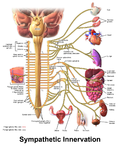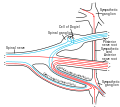| Sympathetic ganglia | |
|---|---|
 Autonomic nervous system innervation, showing the sympathetic (thoracolumbar) and parasympathetic (craniosacral) systems, in red and blue, respectively | |
 Diagram of the course and branches of a typical intercostal nerve. (Sympathetic ganglion visible at center top.) | |
| Details | |
| Identifiers | |
| Latin | ganglia sympathicum |
| MeSH | D005728 |
| TA98 | A14.2.00.011 |
| TA2 | 6169 |
| FMA | 5890 |
| Anatomical terminology | |
The sympathetic ganglia, or paravertebral ganglia, are autonomic ganglia of the sympathetic nervous system. Ganglia are 20,000 to 30,000 afferent and efferent nerve cell bodies that run along on either side of the spinal cord. Afferent nerve cell bodies bring information from the body to the brain and spinal cord, while efferent nerve cell bodies bring information from the brain and spinal cord to the rest of the body. The cell bodies create long sympathetic chains that are on either side of the spinal cord. They also form para- or pre-vertebral ganglia of gross anatomy.
Contents
- Structure
- Sympathetic chain ganglia
- Prevertebral ganglia
- Additional images
- References
- See also
- External links
The afferent nerve cell bodies bring information from the body to the brain regarding perceptions of danger. This perception of danger can instigate the fight-or-flight response associated with the sympathetic nervous system. [1] The fight-or-flight response is adaptive when there is a real and present danger which can be avoided or diminished through increased sympathetic activity. Sympathetic activity could be increased heart rate, dilated pupils, or sweaty palms, for example. The fight-or-flight response is maladaptive when the danger is imagined, prolonged, or when it lasts after the threat is over. When the intensity or duration of the response is excessive, the individual may meet criteria for a variety of psychological disorders. [2] Neuroblastoma tumors can arise from the sympathetic ganglia tissue. [3]



